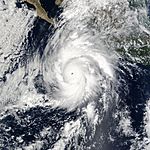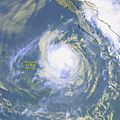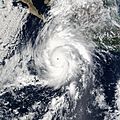2002 Pacific hurricane season facts for kids
 |
|
| Season summary map | |
| First storm formed | May 24, 2002 |
|---|---|
| Last storm dissipated | November 16, 2002 |
| Strongest storm | Kenna – 913 mbar (26.96 inHg), 145 knots (165 mph) – |
| 15 | |
| Total fatalities | 4 |
| Total damage | Unknown ($5–100 million, 2002 USD) |
| seasons 2000 2001 2002 2003 2004 |
|
The 2002 Pacific hurricane season was a time when many strong storms, called tropical cyclones, formed in the Pacific Ocean. The most famous storm this year was Hurricane Kenna. It became a very powerful Category 5 hurricane.
Hurricane Kenna hit land near Puerto Vallarta, Jalisco, Mexico, on October 25. It caused the deaths of four people. It was one of the strongest hurricanes ever to hit the western coast of Mexico. Other storms that year included Tropical Storm Julio, which also hit Mexico. Tropical Storm Boris brought heavy rain to the Mexican coast, even though it stayed offshore.
Some other storms were also special. Hurricanes Elida and Hernan also reached Category 5 strength. But these storms did not cause any damage. Hurricane Fausto did not affect land, but it became a small tropical storm again very far north in the ocean.
Contents
When Did the Storm Season Happen?
| Saffir–Simpson Hurricane Scale | ||||||
| TD | TS | C1 | C2 | C3 | C4 | C5 |
The 2002 Pacific hurricane season officially began on May 15, 2002, in the eastern Pacific Ocean. It started on June 1, 2002, in the central Pacific. The season ended on November 30, 2002. These dates are when most tropical cyclones usually form in the northeastern Pacific Ocean.
During this season, twelve tropical storms formed in the eastern Pacific Ocean. Six of these storms became hurricanes. Five of them grew into major hurricanes. A major hurricane means it reached Category 3 or higher on the Saffir-Simpson Scale. This year, a record three storms became Category 5 hurricanes!
In the central Pacific, one tropical storm, one hurricane, and one major hurricane formed. Overall, there were fewer storms than usual. But there were more strong storms than usual. This happened because of something called El Niño. El Niño also made fewer storms form in the Atlantic Ocean that year.
It was also unusual that no storms formed during the first three weeks of August. Usually, several named storms form during that time.
Meet the Storms
Tropical Storm Boris: Rain on the Coast
On June 8, a stormy area of weather formed. It became Tropical Depression Two-E. The next day, it grew into a tropical storm. Boris reached its strongest point on June 9. Then, it got stuck in the ocean between two areas of high pressure. The winds that guide storms weakened.
Strong winds high in the atmosphere, called wind shear, increased. This made the storm weaker. On June 10, Boris became a depression again. The next day, Boris turned into a leftover low-pressure area. This leftover part moved east and then southeast. It finally disappeared on June 12.
Boris brought a lot of rain to parts of the Mexican coast. Some homes were damaged, but no one died.
Tropical Storm Julio: Flooding in Mexico
On September 23, an area of stormy weather began to spin. It might have been related to another storm called Hurricane Isidore. On September 25, it became Tropical Depression Thirteen-E. The depression moved north and became a tropical storm on the same day.
Julio then turned northwest. It reached its strongest point just before hitting land near Lazaro Cardenas on September 26. The storm quickly disappeared over Mexico.
No one was killed by Tropical Storm Julio. But about 100 houses in Acapulco and Zihuatanejo were damaged or washed away. This happened because of sudden, heavy floods called flash floods.
Hurricane Kenna: A Very Strong Storm
| Kenna satellite image and storm track | |
|---|---|
Hurricane Kenna was a very powerful Category 5 hurricane at its strongest. It was the third Category 5 storm of the season. Kenna hit Mexico as a Category 4 hurricane. As of 2005, Kenna's name was taken off the list of hurricane names. This means its name will not be used again because it caused so much damage.
Kenna killed four people in Mexico. It also left thousands of people without homes. The total damage from Kenna was between 5 million and 100 million dollars.
Tropical Depression Eleven-E: No Damage
Tropical Depression Eleven-E looked like it might hit land. Because of this, warnings and watches were put out for parts of the Baja California Peninsula. But the storm weakened into a leftover low-pressure area before it could become a stronger storm. No deaths or damage were reported from Eleven-E. This storm was the last one of the 2002 season. It lasted for two days in November and disappeared on November 16.
Images for kids
See also
 In Spanish: Temporada de huracanes en el Pacífico de 2002 para niños
In Spanish: Temporada de huracanes en el Pacífico de 2002 para niños



















